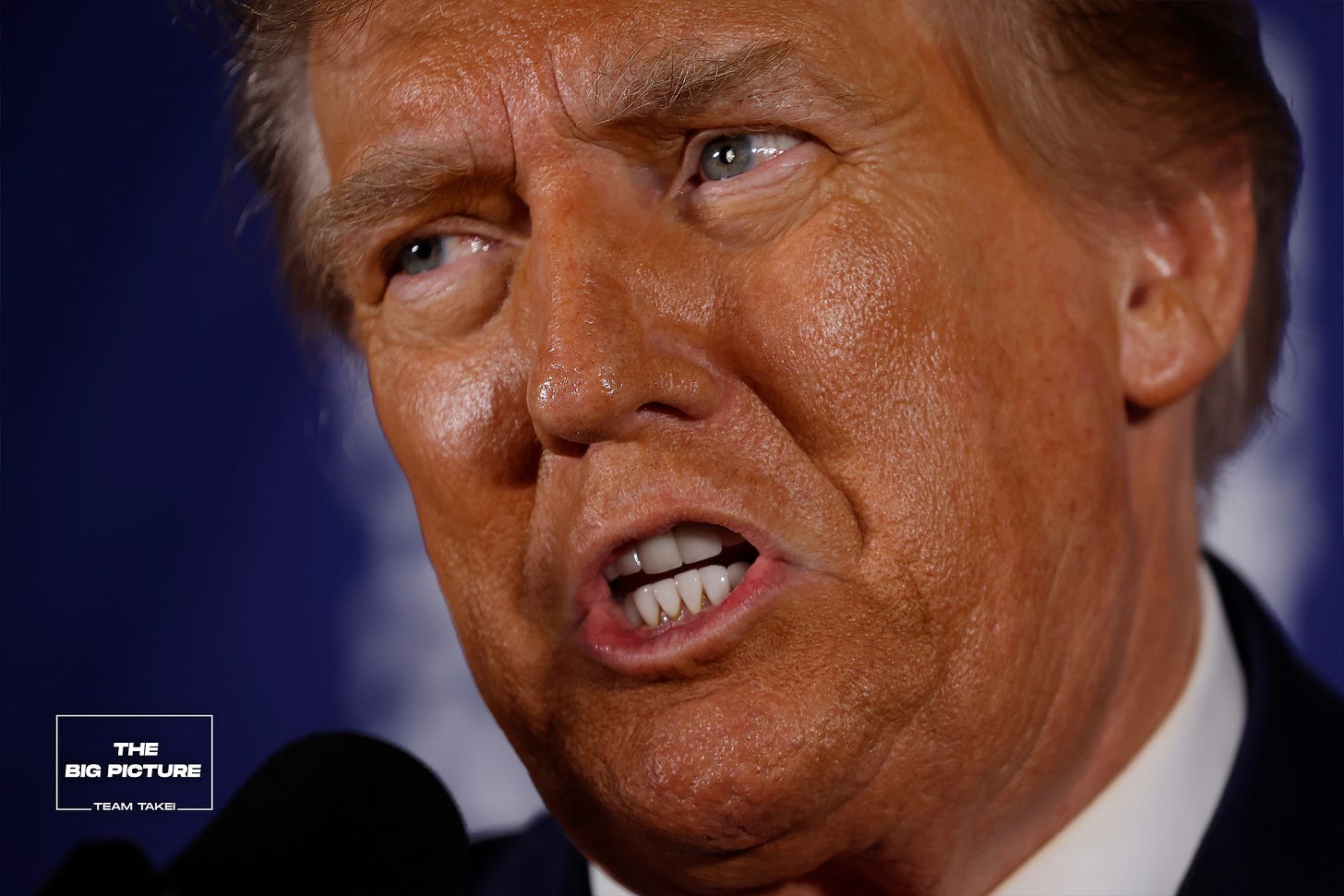The Limits of Trump's Brand of Rage
Donald Trump is winning over MAGA primary voters with his brand of rage politics, but it will be a much harder sell in November

In a recently released deposition of Donald Trump from April 2023 in his New York civil fraud case, Trump defended against the accusation that he artificially inflated his net worth on financial statements, saying:
“Probably my most valuable asset I didn't even include on the statement and that’s the brand.”
He went on to say that the Trump brand helped get him elected President in 2016, which might be one of the few true statements the former guy has ever made.
But back then, his brand—built on complete fiction, mind you, yet still potent in the minds of many voters—was as a “successful businessman” (thanks largely to The Apprentice) and as a “master deal-maker” (thanks to The Art of the Deal.)
But a lot has happened since that brand catapulted him to the presidency in 2016. For four years while serving as president, Trump had to suppress his “businessman” brand, even while he used the office to fleece foreign governments for millions of dollars. (A Democratic House report estimates that foreign governments paid Trump properties $7.8 million in just two years of his presidency.) And with policy failure after policy failure and little in the way of deals to point to, Trump had to pivot.
Now a disturbing new brand has emerged: Trump’s rage.
But in some ways, it’s familiar. In February of 2020, Paul Waldman wrote an OpEd for The Washington Post called Why Trump’s Rage Is Exactly What Conservatives Want. “Rage” was even the name of Bob Woodward’s 2020 book about Trump.
But after his election loss in 2020, his failure to overturn that election, a second impeachment, and a legal reckoning in 2023 which saw 91 felony charges across four different cases, a finding of liability for financial fraud as well as a sexual assault, not to mention the recent $83.3 million judgment against him for defaming E. Jean Carroll…Trump has a lot to be rageful about.
And he hasn’t been hiding it.
Whether in his mugshot in the Fulton County, Georgia RICO case
Or with his demeanor in court during his New York financial fraud trial
it’s clear that he has gone into full rage mode. And thus far, it’s doing the trick for him with Republican voters.
In this essay, I’ll explore why Trump’s brand of MAGA rage appeals to so many voters on the right but could face headwinds in November. I’ll also discuss how this rage is bleeding into Republican politics more broadly as the party seeks to manufacture anger among its base to counter the very real post-Dobbs rage on the left driving political win after win for Democrats.
The Right’s Performative Rage
While Trump undoubtedly has plenty to be angry about, the truth is Trump’s rage is largely performative. He knows how to turn it on like a spigot to get a certain reaction from his base, although lately, it’s unclear whether he knows how to turn it off.
For Trump, this innate sense of how to perform for the camera is one of his superpowers, which was on full display back in 2018 when performative rage was just the thing to save Justice Brett Kavanaugh’s Supreme Court confirmation.
During Kavanaugh’s 2018 confirmation hearing, after Christine Blasey Ford testified, many felt there was little chance he could come back from such a credible witness. But then during his opening statement, Kavanaugh turned on the rage and rode it all the way to confirmation.
The anger he displayed in response to the accusations of sexual assault was at odds with his more measured responses prior to his confirmation hearing.
As Vox reported at the time:
The nominee was visibly upset at points during his opening statement, a markedly different tone from his placid interview earlier this week with Fox News. It also departed from the staid prepared remarks Kavanaugh originally submitted to the committee.
So what changed?
In the lead-up to Kavanaugh’s confirmation hearing, CNN reported that Trump had grown “increasingly dissatisfied” with how Kavanaugh was conducting his own defense in the face of the allegations.
It has led the President to believe that he must personally take charge of defending his embattled nominee ahead of Thursday’s critical appearance before the Senate Judiciary Committee.
…
As Kavanaugh has held back, Trump has unleashed.
Of course, by then Trump had experienced more than a dozen accusations of sexual assault levied against him, and he had a tried and true defense:
[Trump] has often said punching back is the most effective defense.
And so he did, repeatedly. And by all accounts, Kavanaugh followed Trump’s lead during an uncharacteristic opening statement that Slate described as “a defiant howl of rage,” calling it:
thoroughly partisan and utterly disgraceful, a Trumpian Hail Mary that exuded desperation, entitlement, and rage.
It even had the tell-tale signs of Trump’s own brand of rage:
He insisted he was the victim of “grotesque character assassination.”
Importantly:
[Kavanaugh] came out swinging as a Republican, as a man who loathes the Democratic Party just as much as the president who nominated him loathes it.
And in the end, the performance worked. Kavanaugh was confirmed by the Republican-controlled Senate by a 50-48 vote.
What Is At The Heart Of The Appeal Of Conservative Rage?
Trump wasn’t the only inspiration for Kavanaugh’s rage-filled confirmation strategy, of course. Decades earlier, Justice Clarence Thomas was confronted with allegations of sexual harassment by Anita Hill during his confirmation hearings, and he raged his way through it as well, ultimately earning confirmation.
In so doing, Thomas set the stage for the anger defense of men such as Trump and Kavanaugh yet to come.
As The Washington Post points out, three aspects of Thomas’ “shrewd” rage defense got him through to confirmation:
Denial of the charges
Play the victim
Attack the accusers and the process
Sound familiar?
But there’s something else going on here.
In The Washington Post’s 2020 OpEd Why Trump’s Rage Is Exactly What Conservatives Want, columnist Paul Waldman interviewed Dannagal Goldthwaite Young, an associate professor of communication at the University of Delaware, about why such Trumpian rage appeals to conservatives in particular.
According to Young, the key difference between how conservatives and liberals think is related to “how individuals engage with threats in their world.” When conservatives feel threatened, “they are more likely to seek order, predictability and routine in their lives,” whereas liberals have a much higher tolerance for ambiguity.
This is why Fox News and Trump always talk in terms of us versus them, striking clear lines between heroes and villains, with no room for nuance. They know that for their audience, “it’s about identifying people, institutions, parties and policies that pose a threat.”
And so for someone like Trump, who sees everything in such stark black-and-white terms:
The bigger rhetorical advantage…comes from the hugely symbiotic relationship that exists between the structure of conservative outrage and the psychology of conservatives. If you are giving threat-oriented information that’s angry and fearful in a very simple and clear way, you’re identifying what to be mad at and what to do about it, and you’re giving it to people who are ready to take action against whatever is coming at them.
This explains an awful lot.
For example, when Trump makes his weird Big Lie claims about the 2020 election, he never portrays it as close. It’s always, “I won by hundreds of thousands of votes.” It always seemed like an absurd strategy to try make people believe that hundreds of thousands of votes were somehow stolen, rather than just a few thousand in a tight state. But Trump instinctively knows that this lack of ambiguity, as far-fetched as it might seem, actually appeals to his supporters’ low tolerance for nuance. There needed to be no question that Trump was the winner.
A similar tactic has been employed in the right’s demonization of the left, whether it’s QAnon conspiracies about pedophilia or Trump’s usual cries of “communist.” These claims are baseless yet still ring true for conservatives triggered by Republicans’ rhetoric to define a clear enemy.
This explains not just why rage-filled appeals tend to work with conservative audiences, but also why Republican politicians and media spend so much of their time appealing to voters’ fears.
Why Republicans Are Leaning Into The Invasion At The Border
Republicans understand there are limitations to the appeal of Trump’s rage, however. We saw it in Nikki Haley’s strength among independent, moderate, and suburban voters in New Hampshire. The Financial Times found the same in an article explaining why “Trump’s rage falls flat in Pennsylvania.” And Republicans are seeing a new rage from the left, one inspired by the Dobbs decision overturning Roe v. Wade—a ruling by the Court majority that Trump built.
This may explain why Republicans are working overtime to manufacture the rage Trump’s base demands by fear-mongering about an “invasion” of immigrants at the border.
Just look at exit polls out of Iowa that found 40% of Iowa Republican caucusgoers were most concerned with the southern border (versus only 30% for the economy.) This is an absurd notion considering the southern border is nowhere near Iowa.
But this result speaks to the effectiveness of Trump’s immigration rhetoric for conservative voters, inventing the prospect of an “invasion” at the border and the insidious claim that migrants are “poisoning the blood” of our country, a claim with which, shockingly, a supermajority of Republicans now agree.
It doesn’t matter where in the country Republican voters are. Trump has created the prospect of a clear and present—though entirely imaginary—threat to the entire nation, portraying these poor migrants as near supervillains. It’s been a part of Trump’s fear-driven campaign ever since 2016, of course, but in 2024, it’s supercharged, effectively triggering conservatives’ anger and fear, which, as Young points out in The Post, serves as a
perfect vehicle for strategic propaganda and mobilization.
Following Trump’s lead, the Republican Party has adopted this dangerous “invasion” rhetoric, setting up a dangerous “us versus them” standoff with the federal government, and a constitutional crisis as Texas defies a recent ruling of even this conservative Supreme Court. Then there is the GOP House’s refusal to take yes for an answer and its obstruction of a bipartisan border deal, all at Trump’s urging.
This speaks not just to the rhetorical strategies they know work with their base in an ever-escalating election year, but also to the desperation Republicans feel to rile up their base against an unusually rage-filled and motivated Democratic base.
Moving Beyond Trump’s Rage
Perhaps it’s a sign of progress that Trump’s rage defense in the face of E. Jean Carroll’s allegations of rape failed to prevent true consequences, as Trump now owes Carroll tens of millions in punitive and compensatory damages.
In fact, Trump’s performative outrage—claiming not to know Carroll, claiming the allegations weren’t true even after a jury had found him liable for the assault—only made matters worse, leading directly to this second defamation trial. Trump’s rage posts on Truth Social and his angrily calling Carroll a “whackjob” on CNN ended up costing him $83.3 million.
But while the law and the courtroom are the purview of facts, politics is a matter of emotion. So it tracks that, at least so far, the Trump brand of rage is doing gangbusters for him in the GOP primary. But as the race transitions to the general election, where grievance-driven conservative voters are more marginal and less consequential, Trump is going to have to pivot once again.
Trump showed signs of beginning to moderate his demeanor during a recent Fox News town hall, during which he backtracked on his vow to supporters to “be their retribution” and instead said:
“Our ultimate retribution is success.”
But as recently as a week ago, on the night of the New Hampshire primaries, Trump’s rage got the better of him as he lashed out at Nikki Haley in yet another self-own. He played right into her hands, giving her fodder for stepped-up attacks against him and giving moderate voters who fueled her stronger-than-expected second-place finish every reason to oppose him.
While Trump does appear to have a glide path to the Republican nomination, his New Hampshire tantrum points to the limitations of rage as a political tactic. This will especially be true when it comes to the general election, where the negatives of Trump’s character will be blindingly apparent: a candidate unable to shed the rage that has become an all too authentic brand.







Only white men can exhibit rage in the US without being condemned. I disagree with your comparison to a rage-filled Democratic base. Rage is violent and uncontrollable anger. I've seen anger, but I have not really seen rage among the Democrats. Words are important and I think you may have been trying for "balance" or a "both-sides" approach but, in doing that, you seem to be normalizing rage. E. Jean Carroll hasn't exhibited rage, Hillary Clinton hasn't exhibited rage, no one on the left has killed doctors who performed abortions or destroyed clinics where abortions are being performed, all the women coming forward to discuss the health problems and issues related to bans on abortions are not exhibiting rage, Democrats are not stringing up wire and barriers to kill people trying to immigrate into the US, they didn't use violence to storm the US Capital, and they aren't threatening a Civil War. Women and POC are not allowed to exhibit rage in public, and even their anger can't be too demonstrative.
As the vast majority of American’s know, Trump is a liar, a fraud and a con. He is also a terrible businessperson. Below, I’ve placed a list of his failed businesses and his businesses that declared bankruptcy.
Trump’s two moneymaking “successes"? (a) The ridiculously absurd “Apprentice”, where viewers were led to believe that Trump was a successful businessperson, and (b) his real estate condominium projects, which generated billions in cash from two primary sources sponsored by Vladimir Putin – Russian Oligarchs laundering dirty money, Russian Mafia laundering dirty money. If it weren’t for that dirty money, Trump would be in the poorhouse.
Trump’s failed businesses:
1. Trump Steaks
2. GoTrump 3. Trump Airlines
4. Trump Vodka 5. Trump Mortgage
6. Trump: The Game
7. Trump Magazine 8. Trump University 9. Trump Ice 10. The New Jersey Generals
11. Tour de Trump
12. Trump Network
13. Trumped
Truth (Lies) Social
Trump companies that sought bankruptcy protection:
1. Trump Taj Mahal 2. Trump’s Castle 3. Trump Plaza Casinos 4. Trump Plaza Hotel 5. Trump Hotels and Casinos Resorts
6. Trump Entertainment Resorts